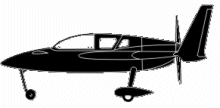
ASN Wikibase Occurrence # 146704
This information is added by users of ASN. Neither ASN nor the Flight Safety Foundation are responsible for the completeness or correctness of this information.
If you feel this information is incomplete or incorrect, you can submit corrected information.
| Date: | Wednesday 11 July 2012 |
| Time: | 12:40 |
| Type: |  Cozy III |
| Owner/operator: | Private |
| Registration: | N718JT |
| MSN: | BUNCH 1 |
| Engine model: | Lycoming O-320 |
| Fatalities: | Fatalities: 1 / Occupants: 2 |
| Aircraft damage: | Substantial |
| Category: | Accident |
| Location: | Winslow-Lindbergh Regional Airport - KINW, Winslow, AZ -
 United States of America United States of America
|
| Phase: | Initial climb |
| Nature: | Private |
| Departure airport: | Winslow, AZ (INW) |
| Denver, CA (DEN) | |
| Investigating agency: | NTSB |
| Confidence Rating: |
The pilot reported that, during takeoff, the airplane became airborne with 3,000 ft of runway remaining. When the airplane was between about 25 and 40 ft above ground level (agl), its nose dropped, and the pilot then pulled back on the control stick. The pilot was able to level out the airplane and establish a 200-ft-per-minute climb rate. As the airplane approached 75 ft agl at an indicated airspeed of about 95 mph, the airplane’s nose dropped to about a 30- to 45-degree nose-down attitude. The pilot again pulled back on the control stick, but he was unable to regain control of the airplane before it impacted the ground.
The pilot reported that the engine was running roughly during an initial start-up, but he stated that it ran normally during a subsequent start-up and two engine run-ups before taking off on the accident flight. A postaccident examination of the engine and airframe revealed no evidence of mechanical malfunctions or failures that would have precluded normal operation. The airplane’s calculated gross weight exceeded its allowable maximum gross weight, and high-density altitude conditions existed at the time of the accident. Although these conditions likely affected the airplane’s performance, the pilot was able to establish a positive climb rate after takeoff; however, he did not maintain control of the airplane as the pitch changed.
Probable Cause: The pilot’s failure to maintain airplane control during climb in high-density altitude conditions and with the airplane’s weight in excess of its maximum allowable gross weight.
Accident investigation:
 |
|
Sources:
NTSB
Location
Revision history:
| Date/time | Contributor | Updates |
|---|---|---|
| 12-Jul-2012 05:48 | 78Delta | Added |
| 12-Jul-2012 05:49 | harro | Updated [Date, Aircraft type] |
| 12-Jul-2012 08:02 | Geno | Updated [Time, Aircraft type, Operator, Location, Source, Narrative] |
| 12-Jul-2012 08:10 | Geno | Updated [Source] |
| 13-Jul-2012 15:58 | Geno | Updated [Source] |
| 21-Dec-2016 19:28 | ASN Update Bot | Updated [Time, Damage, Category, Investigating agency] |
| 27-Nov-2017 20:56 | ASN Update Bot | Updated [Cn, Operator, Other fatalities, Departure airport, Destination airport, Source, Narrative] |
Corrections or additions? ... Edit this accident description
The Aviation Safety Network is an exclusive service provided by:


 ©2024 Flight Safety Foundation
©2024 Flight Safety Foundation